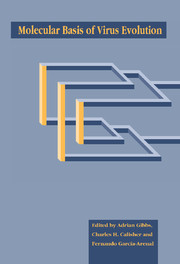Book contents
- Frontmatter
- Contents
- List of contributors
- Editors' preface
- Conference participants
- 1 Introduction and guide
- Part I The impact of viral diseases
- Part II Origins of viruses and their genes
- Part III Sources of virus variation
- Part IV Molecular interactions of viruses and their hosts
- Part V Viruses, hosts and populations
- Part VI Case studies of viral taxa; their systematics and evolution
- 18 Evolution of poxviruses and African swine fever virus
- 19 Molecular systematics of the flaviviruses and their relatives
- 20 Herpesviridae
- 21 Aphthovirus evolution
- 22 Evolution of the Bunyaviridae
- 23 Evolution of the tobamoviruses
- 24 The luteovirus supergroup: rampant recombination and persistent partnerships
- 25 The evolution of the Reoviridae
- 26 Genetic variation and evolution of satellite viruses and satellite RNAs
- 27 Molecular evolution of the retroid family
- 28 Adaptation of members of the Orthomyxoviridae family to transmission by ticks Patricia
- 29 The Order Mononegavirales: evolutionary relationships and mechanisms of variation
- 30 The molecular evolution of the human immunodeficiency viruses
- 31 Molecular evolution of papillomaviruses
- 32 Molecular systematics of the Potyviridae, the largest plant virus family
- 33 Evolution of alphaviruses
- 34 Evolution of influenza viruses: rapid evolution and stasis
- Part VII Techniques for viral systematics
- Index
22 - Evolution of the Bunyaviridae
Published online by Cambridge University Press: 04 May 2010
- Frontmatter
- Contents
- List of contributors
- Editors' preface
- Conference participants
- 1 Introduction and guide
- Part I The impact of viral diseases
- Part II Origins of viruses and their genes
- Part III Sources of virus variation
- Part IV Molecular interactions of viruses and their hosts
- Part V Viruses, hosts and populations
- Part VI Case studies of viral taxa; their systematics and evolution
- 18 Evolution of poxviruses and African swine fever virus
- 19 Molecular systematics of the flaviviruses and their relatives
- 20 Herpesviridae
- 21 Aphthovirus evolution
- 22 Evolution of the Bunyaviridae
- 23 Evolution of the tobamoviruses
- 24 The luteovirus supergroup: rampant recombination and persistent partnerships
- 25 The evolution of the Reoviridae
- 26 Genetic variation and evolution of satellite viruses and satellite RNAs
- 27 Molecular evolution of the retroid family
- 28 Adaptation of members of the Orthomyxoviridae family to transmission by ticks Patricia
- 29 The Order Mononegavirales: evolutionary relationships and mechanisms of variation
- 30 The molecular evolution of the human immunodeficiency viruses
- 31 Molecular evolution of papillomaviruses
- 32 Molecular systematics of the Potyviridae, the largest plant virus family
- 33 Evolution of alphaviruses
- 34 Evolution of influenza viruses: rapid evolution and stasis
- Part VII Techniques for viral systematics
- Index
Summary
Introduction
The family Bunyaviridae is one of the largest groupings of viruses. More than 300 viruses, arranged in numerous serogroups, are contained in the family, and this number is taken as evidence of their evolutionary success and potential. Some of these viruses are associated with serious diseases of humans, such as haemorrhagic fever with renal syndrome, Crimean-Congo haemorrhagic fever, and Rift Valley fever. Hence the family warrants continual epidemiological surveillance. Characteristics that unite the Bunyaviridae include the following: tripartite, singlestranded RNA genome of negative- or ambi-sense polarity; enveloped virus particle comprising four structural proteins - two glycoproteins termed Gl and G2, a nucleocapsid protein, N and an RNA polymerase, the L protein; cytoplasmic site of viral replication with intracellular maturation at the Golgi; viral mRNA transcription primed by capped oligonucleotides cleaved from the 5’ ends of host-cell mRNAs. Considering the large number of viruses that fulfil these criteria, it is perhaps not unexpected that considerable diversity exists at the molecular level in terms of genome coding and replication strategies, and at the biological level in terms of vector and host interactions. These factors will be briefly reviewed in this Chapter.
Biology of Bunyaviridae
The family Bunyaviridae is currently (Calisher, 1991) divided into five genera: Bunyavirus, Hantavirus, Nairovirus, Phlebovirus and Tospovirus. Such subdivision was originally made by serological comparisons but the availability of nucleotide sequence data has enabled more precise classification. (In this chapter ‘Bunyaviridae’ is used to refer to familial traits and the terms bunyavirus, hantavirus, etc, to generic traits.
- Type
- Chapter
- Information
- Molecular Basis of Virus Evolution , pp. 321 - 337Publisher: Cambridge University PressPrint publication year: 1995



